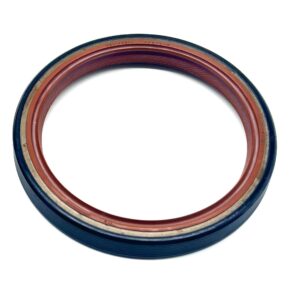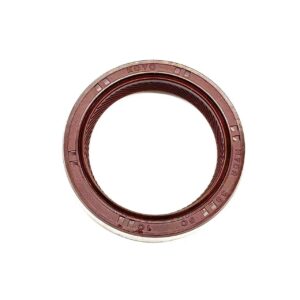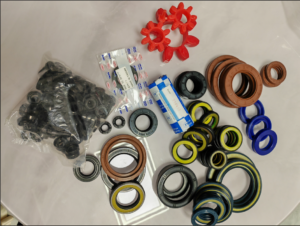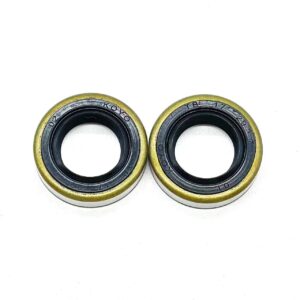Table of Contents
ToggleWhat Are the Oil Seals?
Oil seals, also known as shaft seals or radial lip seals, are critical mechanical components designed to retain lubricants (oil, grease) within machinery while preventing contaminants (dirt, dust, moisture) from entering. They play a vital role in protecting rotating or reciprocating shafts, ensuring smooth operation and extending equipment lifespan. Below is a detailed exploration of their design, functionality, and applications.



1. Definition and Primary Functions
What Are Oil Seals?
Oil seals are devices installed between a rotating shaft and its housing to create a barrier that:
- Retains Lubricants
Prevents oil or grease from leaking out of systems like engines, gearboxes, or hydraulic cylinders. - Excludes Contaminants
Blocks external particles (dust, dirt, water) from entering, which can cause wear, corrosion, or system failure. - Maintains Pressure
Ensures internal pressure stability in applications like hydraulic systems or sealed bearings. - Reduces Friction
Maintains a lubricating film between the seal lip and shaft to minimize wear.
Example: In automotive engines, oil seals retain crankcase oil while preventing debris from entering critical components like crankshafts.
2. Key Components and Design Features
Core Structure
Oil seals are engineered with three primary components:
- Sealing Lip
- Made of flexible elastomers (e.g., nitrile rubber, Viton).
- Conforms to the shaft surface for a tight seal.
- Single-lip: Basic retention (common in low-contaminant environments).
- Double-lip: Adds a secondary dust-excluding lip (e.g., KDAS, DLI seals).
- Metal Case
- Provides structural rigidity (carbon/stainless steel).
- Ensures secure installation in housings.
- Garter Spring
- A coiled spring behind the sealing lip.
- Maintains constant contact pressure against the shaft, compensating for wear.
Anti-Rotation Features
- Notches or tabs on the metal case prevent the seal from spinning within its housing.
- Critical for maintaining alignment in high-speed applications.

3. Types of Oil Seals
A. By Application
- Static Seals
- Used where there is no relative motion (e.g., GA gasket seals for flanges).
- Dynamic Seals
- Rotary Seals: For rotating shafts in pumps or motors (e.g., HBT, JA/FA).
- Reciprocating Seals: For linear motion in hydraulic cylinders (e.g., UN, DHS).
- Wiper/Scraper Seals: Remove debris from rods (e.g., KDAS, DLI).
B. By Specialized Design
- Double-Lip Seals
- Combine primary sealing with a secondary dust lip for harsh environments.
- V-Ring Seals
- Axially mounted for light-duty rotary applications.
- Cassette Seals
- Multi-component designs for heavy-duty industrial equipment.

4. Material Selection
Elastomers
- Nitrile (NBR)
- Cost-effective, oil-resistant, ideal for temperatures up to 100°C (e.g., UN, IDI seals).
- Fluorocarbon (FKM/Viton)
- Resists high temps (200°C+) and aggressive chemicals (e.g., HBT, DHS).
- Polyurethane (PU)
- High abrasion resistance for dynamic systems (e.g., LBH, SPGO).
- PTFE (Teflon)
- Low friction, extreme temperature tolerance (up to 260°C).
- Silicone (VMQ)
- Flexible at low temps but incompatible with petroleum-based oils.
Metal and Springs
- Cases: Carbon steel (standard) or stainless steel (corrosive environments).
- Springs: Stainless steel for durability and corrosion resistance.
5. Applications Across Industries
- Automotive
- Crankshafts, transmissions, wheel hubs, and differentials.
- Industrial Machinery
- Pumps, compressors, and conveyor systems.
- Hydraulics
- Hydraulic cylinders (DHS, UHS) and piston rods (UN).
- Agriculture/Construction
- Excavators, tractors exposed to dirt and moisture.
- Aerospace/Marine
- Jet engine bearings, marine steering systems.
6. Oil Seals vs. Hydraulic Seals
While both retain fluids and block contaminants:
- Oil Seals
- Focus on lubricant retention in low-to-moderate pressure systems.
- Common in engines, gearboxes, and rotating shafts.
- Hydraulic Seals
- Specialized for high-pressure hydraulic systems (up to 5,000+ psi).
- Overlap with oil seals in designs like DHS, UHS, or SPGO.
7. Selection and Maintenance Guidelines
Selection Criteria
- Motion Type
- Rotary: Use HBT or JA/FA for high-speed shafts.
- Reciprocating: Choose UN or DHS for hydraulic rods.
- Environment
- Dusty conditions: Double-lip seals (e.g., KDAS).
- High heat: Viton or PTFE materials.
- Fluid Compatibility
- Avoid chemical degradation (e.g., silicone for non-petroleum fluids).
Maintenance Best Practices
- Installation: Use alignment tools to prevent lip damage.
- Inspection: Check for cracks, hardening, or wear during routine maintenance.
- Replacement: Swap worn seals promptly to prevent leaks.
8. Conclusion
Oil seals are indispensable components that safeguard machinery by retaining lubricants and excluding contaminants. Their design—featuring a flexible sealing lip, rigid metal case, and garter spring—ensures reliable performance across industries, from automotive engines to aerospace systems. By selecting the appropriate type (single/double lip, rotary/reciprocating) and material (NBR, Viton, PTFE), engineers optimize equipment efficiency and longevity. Regular maintenance further ensures these seals continue to protect critical systems, minimizing downtime and operational costs. Understanding their role and specifications empowers industries to maintain robust, contamination-free machinery in even the most demanding environments.



Leave A Comment